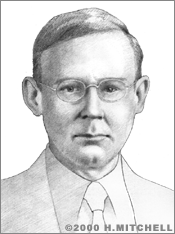Wallace Carothers
E.I. DuPont de Nemours & Company once called Wallace Hume Carothers "one of the most brilliant organic chemists" the company had ever employed. In the nine years he spent working there, Carothers (1896-1937) made contributions to the theory of organic chemistry that led to the invention of polymeric materials, such as the synthetic materials nylon and neoprene, the first commercially successful synthetic rubber.
Carothers was born April 27, 1896 in Berlington, Iowa as the son of a schoolteacher. After receiving a BS from Tarkio College, Carothers obtained his master's and doctoral degrees from University of Illinois.
After his graduation, Carothers became an instructor at Harvard University, where he started experimenting with chemical structures of polymers with high molecular weight. In 1928, DuPont lured him away from Harvard to work in a new research lab in Wilmington, Del. for developing artificial materials. There, he investigated the structure of substances of high molecular weight and their formation by polymerization.
In 1931, due to political and trade troubles with Japan, the United States' main source of silk, that fiber was getting harder and more expensive to come by. DuPont wanted to develop a synthetic fiber that could replace it. In 1934, Carothers and his team set out to produce a strong, elastic fiber that would not melt below 195°C. Carothers formulated a new strategy for synthesizing giant molecules, and that year, Carothers and his team pulled the first long, strong, flexible strands of a synthetic polymer fiber out of a test tube. They realized immediately that this artificial fiber had properties similar and in many ways superior to such natural fibers as wool, cotton, and silk.
The new super-polymer reached the market in 1937 in the form of toothbrush bristles advertised as superior to anything plucked from the hide of an animal. In 1938, DuPont went public, announcing the invention of nylon, "the first man-made organic textile fabric prepared entirely from new materials from the mineral kingdom." Nylon stockings, modeled by women at the New York World's Fair in 1939 and put on sale in 1940, were a huge hit.
Meanwhile, frustrated at times with the flaws of his "silk" superpolymer research, Carothers set aside the project to investigate another interest of his – cyclic compounds. One of them, he noticed, gave off an intriguing aroma. Marketed as Astrotone, it became the first synthetic musk. The Carothers group also continued to work on another creation, a polymer that became neoprene, or synthetic rubber.
In the course of his research, Carothers published 31 papers, establishing general theories about polymers and regularizing the terminology of the field. He had brought the world not just nylon, but also knowledge of natural polymers and how they are formed. In 1935, Carothers was the first organic chemist elected to the National Academy of Sciences.
In 1936, Carothers married Helen Sweetman, a colleague of his at DuPont. A year later, he tragically committed suicide after a lifelong bout with depression. However, Carothers' legacy lives on. Nylon is used all over the world today in a variety of applications including apparel, carpeting, home furnishings, and industrial products. Its invention marked the beginning of a new era of synthetic fibers, which continues to expand.


